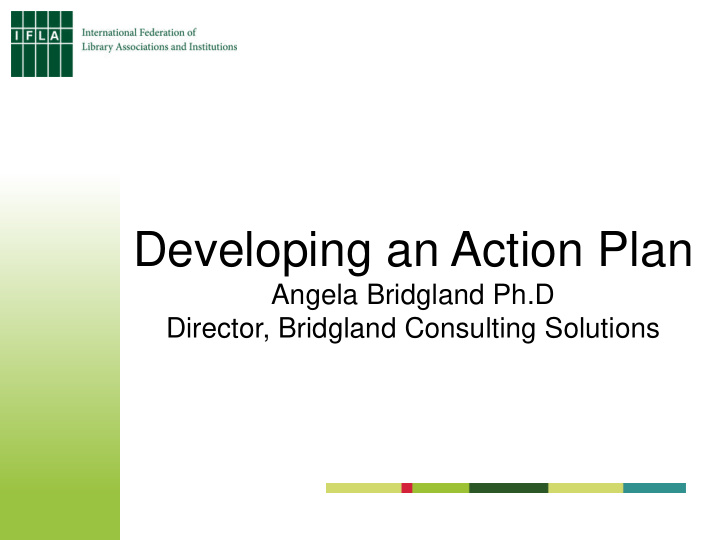



Developing an Action Plan Angela Bridgland Ph.D Director, Bridgland Consulting Solutions
Overview • Why you need an Action Plan • Key steps of an Action Plan • Explanation of Action Plan template • Practical exercise
Why an Action Plan is important • The key purpose is to turn priorities into action. • A plan helps to define why the action is important and defines who does what by when. • The plan focuses effort and enables collaboration and communication.
Key Steps (1) 1 . Define what you want to achieve and what the outcome will look like. 2. Identify what you need to do to achieve your goal – list key steps, tasks, timelines and outputs. 3. Consider scheduling. What are the most critical things to be done and by when. Consider if some tasks could be done in parallel to speed up completion.
Key Steps (2) 4. Identify who is responsible for doing what and by when. Recognise the importance of teamwork. Where possible, encourage other Sections or SIGs to become involved. 5. Consider working with relevant groups/organisations external to IFLA. 6. Share what you are doing and why. Communicate, communicate, communicate.
Key Steps (3) 7. Decide what resources you will need and how to get them (apart from money, these could include time, people’s expertise, space etc.) 8. Stay on track. Stick to your plan. 9. Evaluate progress toward achieving your goal. 10. Develop contingencies. Anticipate problems and think how best to avoid them.
Key Steps (4) 11. Evaluate how well your goal was achieved. 12. Consider how things might be improved in the future. 13. Celebrate success. Acknowledge people’s efforts and contributions. 14. Share results/outcomes.
Exercise (15 minutes) • Select an activity from the Key Initiatives that support the new Strategic Plan. • Use the Action Plan template to turn one of your priorities into an action plan. • Leave the final Communications column blank as we will focus on this in a later exercise.
Commmunications Plan for Sections and SIGs
Introduction • Louise Edwards • Joined IFLA in March 2015 • Director, Professional Strategies • Formerly Director, The European Library • Graduate linguist (Spanish/Russian/Portuguese)
Overview • Why you need a Communications Plan • Main elements of a Communications Plan • IFLA Communications Strategy • Practical exercise (led by Angela)
Why you need a Communications Plan • To raise awareness and inform others of what you’re doing • To increase interest and engagement in what you’re doing • To influence or persuade others to do something
Main elements of a Communictions Plan • Objectives of your communications – What are your communications trying to achieve? How do they support your action plan? • Define your Audiences – What do you know about them? What do they know about you? • Design your Messages – What do you want to say to your audiences and why • Plan your Means – How will you communicate? By when? • Evaluate your results – What is the impact of your communications? How will you measure it?
IFLA Communications Strategy • Communications objectives – To support the Strategic Plan and Key Initiatives • Raising awareness and facilitating implementation • Changing attitudes and perceptions about libraries and the libraries/information profession • Audiences – Members, Affiliates, global library and information community – International organisations e.g. UN, UNESCO – Government – Education – Business and Enterprise – Creative industries e.g. publishers, media
IFLA Communications Strategy • Examples of key messages – Libraries and librarians/information professionals are enablers of social, economic, cultural development and progress – Libraries and librarians/information professionals are active change agents – we innovate, we transform communities – IFLA expresses the collective, trusted voice of the library and information community • Examples of means of communication – New redesigned IFLA website – Social media (Twitter, Facebook, Instagram etc.) – Promotional materials (e.g. flyers, brochures etc.)
IFLA Communications Strategy • Examples of evaluating results – Google Analytics • Not only quantity (e.g. pages viewed) but quality (how long did they spend on the website? How many people have returned more than once?) – Social media statistics – Downloads – Measuring impact of individual campaigns (which campaigns are ‘hot’ and why, which ones didn’t attract interest and why) – Number of people signing up to campaigns, statements etc. and what they do (is engagement active or passive?)
“Be the change that you wish to see in the world” Mahatma Gandhi
Exercise • Select the activity that you worked on for your Action Plan and focus on the communications plan for this activity. • Use the separate Communications Plan template to help you do this.
Summary and Next Steps Joanne Yeomans Professional Support Officer
Summary Today’s session has provided advice and guidelines on how to develop: • a basic action plan • a basic communications plan in the context of IFLA’s new Strategic Plan.
Next Steps • Provide feedback on the new Strategic Plan by September • Use the ideas and tools provided to develop action and communications plans for your Sections/SIGs
QUESTIONS?
THANK YOU
Recommend
More recommend